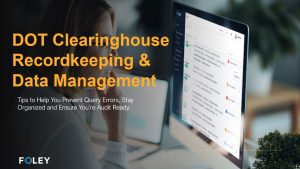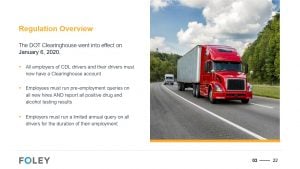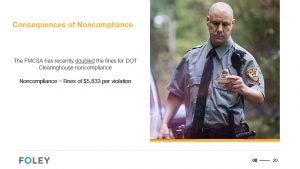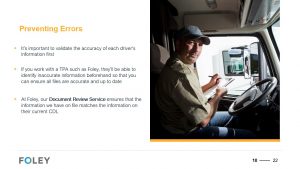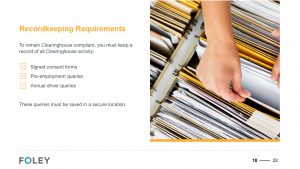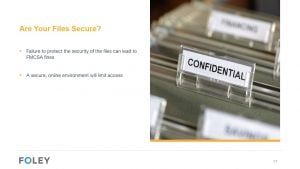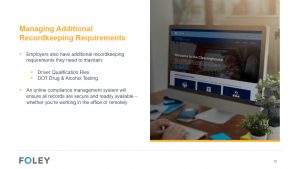Webinar Transcript: Ask The Experts: Clearinghouse Recordkeeping & Data Management

Below is a full transcription of our popular webinar on DOT Clearinghouse compliance and tips called “Ask the Experts: Clearinghouse Recordkeeping & Data Management.”
Hello everybody. And welcome to this webinar on the DOT Clearinghouse.
We will be getting going in just a minute.
So, we’re going to give everyone a chance to log in, so just sit tight and we will kick this off in just a moment or two. We do expect a lot of attendees for today. If you’re logging in now, welcome. We will be getting started in just a few minutes, so just hang in there. We’ll give it 60 more seconds or so for people to log in and get ready and then we will kick this off and talk through the DOT Clearinghouse Recordkeeping and Data Management topic for today.
So we are just waiting for a few last participants to join today. We will be getting going very soon. So thank you for your patience and we will be getting started here in just a moment.
So, welcome everybody. I’d like to thank you for attending. This is the DOT Clearinghouse Recordkeeping and Data Management webinar that we are putting on here at Foley. And our goal today is really to share information related to the DOT Clearinghouse – what we’ve seen over the first year, as well as tips to help keep you organized and make sure you’re in compliance, as well as identifying any of the snags that people have been running into and issues that have caused errors for some of the people transacting with the Clearinghouse so far.
So we are going to run through a brief presentation regarding those topics. And then I want to leave enough time today to make sure we open up the floor for questions. In the actual webinar app, you should find a place to submit questions. So if at any point you do have any topics that I am covering that you have a question on, or perhaps there’s something that we don’t cover today that you want to get out there and get at; I will do my best to get through the questions at the end of the session. And we can hopefully touch on anything that we don’t cover today live in a follow-up communication.
So with that, I will dive right in. First off, I’d like to start off by introducing myself. My name is Scott Mogensen. I am the Director of Compliance Operations here at Foley. And it’s a pleasure of mine to get a chance to talk with people in the industry about subjects, such as the DOT Clearinghouse and DOT compliance. So I always appreciate the chance to put on these webinars. I’ve been doing this for about 15 years here at Foley. And again, certainly thank you everybody for taking the time today to go through this.
Regulation Overview
So I guess we’ll start with an overview of the DOT Clearinghouse. The Federal Motor Carrier Safety Administration did put out the Clearinghouse regulation some years ago, and it went into effect on January 6th, 2020. And what it basically does is it requires employers of CDL drivers to check a federally-managed database for drug-testing violations related to DOT drug testing programs. So the drivers themselves and the employers must have accounts in this Clearinghouse and the employers have to run queries both at the pre-employment stage for new hires, as well as on an annual basis over the course of the driver’s employment to ensure that there’s no prohibited conduct in the DOT Clearinghouse that has been registered as the result of a positive drug test or alcohol test or refusal to test, that’s occurred either for the company that the driver’s currently working for, or a previous employer where they had been driving in the past.
So, this is really a positive thing for the industry as a whole, because it’s a better solution to being able to make sure that drivers who have previous conduct in terms of prohibiting or violating the prohibitions of the DOT’s drug and alcohol program, can’t slip through the cracks and just go work for another company while they still have a drug or alcohol problem. The Clearinghouse provides a central place where carriers can check to make sure their drivers are good to go.
Enforcement Action
Now, with that regulation going into effect on January 6, 2020, it’s now been enforced for around a year – just over, in fact. So what that means is we’re starting to see enforcement action, and auditors are checking for Clearinghouse compliance. And there are certain steps that carriers must take to ensure that they’re going to pass these audits and have everything in order when they are audited.
So some of the first things that you want to make sure are squared away are: number one, that employers have to be registered. That’s a relatively easy thing for an auditor to check, and the employer needs to be registered in the Clearinghouse, have their account because by now you’ll have had to be interacting with the Clearinghouse either because of hires that you’ve had since January 2020, or by now you should have annual queries on your record for any drivers that you have employed in a CDL capacity. Similarly, those actual queries need to be checked during an audit to make sure that you are taking the steps on the pre-employment basis and the annual basis so that the auditor can see that, and understands that, you are complying with those requirements.
And then finally, you need to make sure that any violations that have occurred for your program, whether they’re positive drug test results or things like refusals to test, or a positive alcohol result, are making their way into the Clearinghouse. So if you have any of those situations where someone that tested positive on a pre-employment test, the auditor is going to want to enforce the fact that you are taking the necessary steps to ensure that either you as the employer are submitting that information into the Clearinghouse for an alcohol or refusal situation, or if you have an MRO that you work with, that the MRO is ensuring that the violation does make its way up to the Clearinghouse.
Consequences of Noncompliance
And the consequences of this were actually recently stiffened. So in January of this year, the FMCSA made a change and increased the civil penalty that you could face, the fine which could be $5,800 per violation based on Clearinghouse violations that occur. So that change was published in the Federal Register. And certainly, it’s a significant one given that it’s per violation. So, if there are situations where an auditor finds that there are multiple cases of things that should be happening in the Clearinghouse that are not, a carrier could be in line for a pretty hefty fine. And certainly, I think a big part of what we’re doing here today is we want to make sure that doesn’t happen. It is important to point that out because that is a pretty significant consequence. And we want to make sure that everyone does stay in compliance.
The Impact of Data Entry Issue: Query Errors
So let’s talk a little bit about data accuracy, because one of the things that we at Foley have seen is that there have been a number of cases where different carriers have been running into challenges with queries that they’ve been attempting to run that are coming back as unable to be completed because the driver’s information can’t be verified. So the background here is that when you actually submit a query request into the Clearinghouse, you’re going to be passing in information to identify that driver. And it’s going to be the name of the person, their date of birth, as well as information off of their CDL. So their license number, what State that license was issued from, and that information is being checked against the State licensing agencies, so that you can uniquely identify who that person is and find out if they have any violations.
Well, if that information isn’t exactly accurate, or exactly reflected as the way it appears on that CDL, what the Clearinghouse is going to do is it’s going to tell you that there was an inability to verify that driver. So basically, they can’t match that driver to somebody that is licensed in the state licensing agency. And you’re not going to get a result, which obviously is what you need in order to comply with the Clearinghouse regulation. So, it’s very important that employers take the time to validate and verify that they have the right information on file for each of their drivers. Which sounds pretty straightforward, but even small differences in the spelling or presentation of the name in terms of how you might refer to the person versus how it appears on their license. Or the actual license number itself, which each state has a slightly different format and you want to make sure it’s exactly as it appears, no spaces or dashes or any type of special characterization, and basically reflects exactly the way it is when that query is being run so that you can have the best success rate.
Preventing Errors
What we see in our data is that at least 5% of query requests are getting denied because of bad information, which certainly is higher than we’d like to see. So definitely, I think our guidance would be to take the time and make sure that you do get the information correct on that commercial driver’s license so that you can have the highest success rate possible when you’re executing the query. Now as I said, that’s the first step in preventing the error, so make sure you have the right information validated to the maximum extent possible. You want to get a current copy of that license just to make sure that it’s good, if you can. Or of course, if you work with a third-party administrator such as Foley – really try to enlist them to help you and get that inaccurate information cleared up so you have the confidence that the information is correct in your system.
So as an example, here at Foley, we have our document review service, which is frequently paired with our driver file program where that document that’s submitted into the driver file, in this case, maybe a copy of the license, is actually reviewed by a person to ensure that the data coming in matches exactly with the record that you have in your system. So, some of you may keep track of your files on paper, which of course, we don’t recommend because of the possibility of data entry errors and just the advantages of doing things electronically. But if you can, you might want to consider looking at an electronic solution with some type of review service like this, where there is actual review to make sure that the data is accurate and it’s aligned with what the state licensing convention is, so that it can spot any errors if you happen to have too many characters for the state you’re entering, or isn’t in the right format, it’ll catch the that. But that way also, when you go to submit the query, you have the confidence knowing that it’s not going to get rejected in that regard.
So, definitely take the time to do that. That’s one of the big takeaways we’ve seen, especially as people in recent months have been completing their annual queries and trying to get those annual queries done on drivers that they had employed over the course of 2020.
Clearinghouse Recordkeeping: Recordkeeping Requirements
So, moving on to the next topic that we wanted to talk about today, we wanted to really talk a little bit about recordkeeping and what you need to be doing in order to be in good shape for any audits or reviews that you have and what documents you want to be keeping related to your Clearinghouse compliance. As you probably know, in order to be able to prove that you’re complying with the Clearinghouse requirements in Part 382, you’re going to need to be able to have that documentation either electronically or in a secured location, if it’s a physical copy, to show that you have proof of certain key documents. So, consent forms are one of the big ones that you want to make sure you have. This is both for DOT compliance, and because there are Privacy Act and FCRA implications, FCRA being the Fair Credit Reporting Act, to the Clearinghouse itself. You really want to make sure you have those consent forms that you need to have your drivers complete in order for you to be able to run those annual queries on their driving record. So, those consent forms, and we’ll talk a little bit about what format they need to be in a second here, but those consent forms need to be stored and saved so that you can present them if you’re ever challenged on them. But additionally, you need to have records relating to the queries that you’re running – both the pre-employment and the annuals.
So, all of these records need to be saved, they need to be in a secure location, and you’re going to want to have them in such a manner that within at least 48 hours of being presented with the need to produce them, you can retrieve them. We’ve heard of certain carriers storing them offsite in a physical format. Definitely electronic is best because you have access to it anywhere. But if you are going to store them in a physical secured location, you want to make sure access is limited, but you also want to make sure that they’re not too remote where you can’t produce them if an auditor suddenly requests them. Certainly, given the rise of offsite audits and the possibility that you’ll have to upload this documentation to present in an offsite audit, you want to make sure that they’re easily accessible and that you can get them scanned in and uploaded as quickly as possible.
Query Recordkeeping
So, let’s talk a little bit about the recordkeeping specifically to queries. As I mentioned before, there are two main types of queries. So, there’s the full Clearinghouse query, which is mainly run for the pre-employment purpose. That type of query is really what’s going to disclose all the details related to the drug and alcohol violations that may have been submitted. If your driver’s gone through the return-to-duty process, it’ll have updated information related to how they’re progressing with that. And if they’ve completed that process – it’s very specific as to whether or not they’re prohibited or not prohibited and what the next steps are there. So, that type of query does actually require an electronic driver consent to be consented to in the Clearinghouse itself.
So, many of you by now have probably been advocating to your drivers the need to register themselves in the Clearinghouse. And the reason for that, is that you want the drivers to actually go in and register their own accounts in the Clearinghouse because when you do this full Clearinghouse check, the driver needs to be able to log into the Clearinghouse as themselves, see that you’ve requested the full query on them, and actually check the box to consent and say that they approve of you getting their full record. So, that’s going to be required on the full Clearinghouse query. The query itself will be logged in the Clearinghouse, so you can always go back to the Clearinghouse itself and see your former record of that query – so that will be there.
But we also recommend keeping a copy of that Clearinghouse check so that you have a record of it. Especially if it’s a case of a, a violation or something that was indicating a prohibited driver, and therefore, you took some action based on that. But the consent itself will be stored in the Clearinghouse because it was electronic direct within their system.
Now, the limited Clearinghouse check is something that can be run on an annual basis. To fulfill that requirement, that at least once every 12 months on any CDL driver that you employ, you will need to ensure that you’ve run a limited Clearinghouse check. So again, if the requirements of Part 382 for drug testing do apply to that driver, you’re going to need to ensure that you’re running a check at least once every 12 months.
The limited is usually the way you want to go there because you can use a blanket consent form that you have signed by the driver prior to the query being executed. And usually what we see with carriers is that you have that consent form signed at the beginning of employment, and it’s good for the duration of their employment. So you don’t need to get a new one every year; rather you just use that same consent form that can stay current through their employment.
Now, when you get the result back on that, it’s going to have less detail, but it’s going to indicate whether or not that driver is clear and not prohibited or it’ll indicate if there were records found. And if there were records found, you’re going to convert that into a full query and go through that process. But in terms of the consent form itself, you will need to keep records of that consent form because it’s external to the Clearinghouse, meaning, you got the driver to sign it outside of the Clearinghouse. You’ll need to make sure that you are keeping record of that, and you have that handy.
Similarly, the result itself is something that you’ll want to store to be able to prove that you did run this query on each of your drivers so that you can be able to answer that question. If you’re asked to prove that you’ve run one on a certain driver that might be randomly picked from your driver roster, make sure that you have a means of doing that, or are partnering with a TPA that does keep records of that for you.
Consent Recordkeeping
Now, specific to the consent requirements; as I mentioned before, there are Privacy Act and Fair Credit Reporting Act implications to the Clearinghouse. So, it’s very important that you do have these consents and you’re able to keep records of them and document it. Make sure that you definitely have a signed copy and you have one for each driver prior to executing the query. So, that’s something you want to do – you want to make sure you’ve checked that off or registered it if you’re using a TPA or a system that you have that record on file. It can be captured electronically or on paper. But you have to make sure you keep these records for the duration of time that the driver’s employed and likely you want to have the language of that consent overlapping with the period of time the driver’s employed, meaning the language of it should basically say you have the right to run that query for as many years as the driver drives for you.
Important Consent Reminder
When it comes to your consent form, make sure that you do have either your HR, your legal team or whatever resources you do use, review the legal documents you produce for your company. Make sure they’ve taken a good look at it and make sure it covers the standard points. Certainly, at Foley, we can help you with that. We have standard language that goes along with this requirement, and we definitely recommend every carrier takes a look at that. The way you want to go there is making sure that that consent gives you the right to run that unlimited number of queries over the duration of the time that driver drives for you. That way, once you get it and put it in their file, either electronic or in a secured physical location, and you have that as long as you need it.
Advantage of Automation
So, we’ll talk next a little bit about what steps you can take to make sure that you have as much process automation as is necessary. And that really goes to the different steps and procedures you’ll need to take or execute upon in the event of either executing your queries, your Clearinghouse program, or if you are in an enforcement situation.
Are Your Files Secure?
One of the things I mentioned earlier, and it’s worth repeating here, is that you do want to make sure that wherever you do keep your records of both the Clearinghouse queries, as well as the consent forms themselves, that it’s secure and it’s limited access. Because there is confidential information in these queries, especially in the case of anyone that has any type of prohibited conduct, that information is protected and needs to be secured so that it doesn’t negatively impact the employment rights of your employees.
Make sure you do have it in a secure location. Obviously, this is something that will be looked at during an enforcement situation in terms of, you know, do you have the records, can you easily produce them, and is it able to be retrieved and restricted? So, our recommendation is obviously an online environment. It protects both the access aspect of it, where only people with certain credentials can log in and see it. But additionally, it protects against the possibility of the physical copies getting destroyed. We’ve heard of a number of carriers that have had fires or floods, and certainly you don’t want your required documentation destroyed because of situations like that. So, we always recommend electronic storage as the best means of ensuring that you can get the access, the security and the survivability of those required documents squared away.
The Advantage of Automation
Furthermore, there’s an advantage to having things electronic where you can receive alerts and notifications when a due date is approaching. So, the requirement in the Clearinghouse for the annual queries is that certainly within at least once every 12 months, you need to have a limited query run on each of your drivers who are subject to Part 382. So that means you basically have to keep track of when the last time you ran a query on that individual was, and keep note of anyone who is approaching their date where they have to have another one run.
There are many, many ways you can go about doing that. Certainly, you should take the time to figure out what way is going to work best for your company. But definitely at Foley, a tool like our Foley Platform is something that we really have put a lot of thought into, and we think that it can really benefit carriers in terms of having a centralized place to manage that and receive alerts and notifications so that you don’t have to keep track of these dates externally, but rather they’re alerted to you. And that any action that’s upcoming can be brought right to your attention so that you know what you have to do to stay on top of what’s going on with your company’s compliance.
Managing Additional Recordkeeping Requirements
Additionally of course, the Clearinghouse is its own requirement and is brand new in terms of only being about 13 months since the enforcement date started, but certainly it’s tied in with the rest of your driver records. So, a lot of what I’ve been saying around the advantages of going electronic also holds true for the rest of your driver records, like your driver qualification files and your drug testing records. Both of those will have the same advantages of being kind of tied together in an essential place and able to be accessed whenever you need them. And since they’re already electronic, it makes preparing for things like offsite audits a little bit easier because you can simply work with the records in a system from wherever you happen to be with an internet connection. So definitely, give some thought to what your recordkeeping solutions are. That’s something that we see a number of carriers transitioning over to, and they are really taking advantage of the benefits of.
TPA = Automated Compliance
And then, finally, you really want to look at any of your options out there for partnering with a TPA. So, a third-party administrator that really has a lot of depth in both the DOT and background screening worlds can help you maintain this program and take a lot of both the guesswork, as well as the actual automation of the process, off your shoulders and make sure that they’re taking on some of that work for you and making sure you stay in compliance. So obviously, that’s part of what we do here at Foley.
There are a number of ways that you can find partners out there in the country to help you with things like helping you get your account registered, or stepping your drivers through their own registrations. If you have drivers that are having trouble getting themselves registered, there are electronic tools that can help. So, getting all those consents from your drivers, that either you currently have employed, or the ones that you’re looking to bring on board – if you can capture that with an electronic tool, it just makes the whole process kind of run smoothly.
You want to have the background there in terms of the legal aspects of it. And then, software to actually do the reviews and keep the records is really a big advantage for all the reasons I’ve covered so far in here. So really, look at what you can do there to try to get as automated as possible, electronic as possible, because that’ll just help you in terms of preparing for audits and making sure that you have all your ducks in a row when your program is reviewed by an enforcement agent.
Have Questions? (860) 815-0764
So, with that, here’s a number you can call at any time if you have questions. Certainly, at Foley, we’re always happy to talk to anyone and try to steer you in the right direction in terms of any assistance we can provide. But I do want to at this time make sure that we give everyone a chance to go into the webinar tool and submit any questions that you do have that we can answer today on the call. So, I will pause for a minute here. I see that there are some questions that have already been submitted, so we’ll just give it a second for people to basically go ahead and ask any questions that they have. And after that, I will run through as many as I can. And like I said, if I don’t get to your questions, and we don’t have time to get through everybody’s, we’ll try to keep a log of those and either reach back out to you or cover what your question was in a future webinar session.
So, I see that they’re popping in here, I’ll just start with some of the ones that have been submitted already. So, one of the questions that I see here is, you know, what does an employer need to communicate to their CDL drivers about the Clearinghouse? There’s probably a number of things there to answer that question that you want to make sure your drivers are aware of. First and foremost, I think you do need to have aspects in your DOT Policy for your drug testing program to make sure that you’re spelling out what is required of that driver related to the Clearinghouse. So, the fact that they will be subject to queries, the fact that they will have to consent to these queries – you want to make sure that that’s covered in the policy.
But furthermore, I think one of the things, just as a best practice, you want to make sure you do as much as possible in advance, is make sure the drivers are understanding that they need to go in and they need to make sure that they are registering themselves. And while that’s not technically required for every driver; any driver that has to provide consent on a full query, is going to actually have to log into that Clearinghouse. So, the more they do that registration in advance, the more it’s actually going to cut down on the amount of time that it takes to go ahead and get that full query run. So, in the case of a limited query, if you get a “records found” result, which means that basically, the limited query found records, and now you have to run a full; you have to run that full within 24 hours. So, you want to get that driver registered in advance so that you’re not waiting for them to go through the registration steps.
And kind of on that point, one of the next questions I see is, you know, “how do I know if my drivers have registered in the Clearinghouse?” That doesn’t really have a great answer, so I’m sorry to say that there really isn’t a way other than the driver telling you themselves that they have registered for you, as an employer, to know that they’ve registered. The Clearinghouse doesn’t give you that visibility, but you know, that’s where just open dialogue with that driver to make sure they understand that they need to register, have them come back to you and tell you that they registered. Or if you do partner with a TPA, that kind of walks them through the registration process. That’ll give you a little bit of peace of mind to know that they have actually taken that step – they’ve gone in and registered and they’ve done what’s required.
So that was a good question. Next one up is, “am I required to do a full query on myself if I’m an owner operator?”, and the answer there is yes. Essentially, if you’re an owner operator, you have to treat yourself as both a driver and the owner of the company, so you’ll actually have to register as both of those entities. And, unfortunately, you do have to have a full query run initially if you’re starting up your own company, and you do have to run an annual query on yourself, which hopefully there’s no surprises in that, but that is a requirement that you will have to do.
The other aspect that I will also mention on that front, is that as an owner operator, there is a requirement that you do designate a TPA. For every other type of carrier other than owner operators, it’s a choice if you want to work with a TPA and certainly there’s a lot of advantages to doing that. But as an owner operator, you’re required to, and that’s because the DOT wants to ensure that if there are violations that occur related to you personally, in terms of an alcohol violation or a refusal situation, that your TPA will actually report that violation into the Clearinghouse. I would be remis if I didn’t point out that as an owner operator you will have to actually do that step of designating a TPA for that.
So, then the next question here, and I’ll just keep running through them. So looks like we have a lot of good ones flowing in, so thank you very much, everybody for your submissions. This next question is, “If you do not have a CDL, you do not need to register in the Clearinghouse?” and they’re basically asking if that’s correct. That is true. So, the FMCSA Clearinghouse is required for all drivers who operate commercial motor vehicles that meet the definition of 49 CFR Part 382, which is essentially the DOT drug testing regulation for FMCSA, and that’s any vehicle that really requires a CDL to operate. So, if you are operating a vehicle with a gross vehicle weight rating of 26,001 pounds or more, or it’s designed to carry 16 or more people, including the driver as a passenger-carrying vehicle, or if it’s placarded for hazmat.
So, if it meets any one of those definitions, the driver of that vehicle is going to be required to have a CDL and they’re going to be required to be in the Clearinghouse. Now, if you don’t meet that definition, and you’re driving a different type of vehicle, maybe something either a little bit smaller or something that would put you in the realm of needing a driver file and being DOT-regulated but not requiring drug testing, those types of drivers do not need to be queried in the Clearinghouse or have violations submitted into the Clearinghouse. So, if your company has a drug testing program on its own company authority; you don’t submit those non-federal, non-DOT drug test results into the Clearinghouse, and you don’t have to run queries on those non-CDL drivers. That’s a really good question. It’s really the CDL drivers specifically where you need to run those queries.
So, the next question here is, from a TPA standpoint, “is there a way to select a pre-employment query specifically and is that necessary?” Yes, there is actually a designation for pre-employment. So, at the outset, when you go to run a query manually, there is an opportunity to select limited or full, which are the general categories. But then within the full query, there’s a pre-employment sub-option. So, specifically, you can designate between those, and if you work with a TPA, they can actually make sure that you’re running the right type of query for the right type of situations.
And then, there’s a note here – this is more of a comment than a question – but a good point, nonetheless. We want to make sure that we do call out, I think this carrier is potentially either crossing the border or located in Canada. And we do want to make sure that we point out while this is a USDOT regulation, it’s going to apply to anybody that does drive within the United States. So, if you have drivers coming across the border from either Canada or from Mexico, coming north; if you’re operating inside the United States of America, you are going to have these requirements placed upon you. So, good call out there from whoever submitted that question.
But it looks like we do definitely have a number of points here. So, one of the last ones I’ll go through here and then we’ll start to wrap up. “Can an employer require the employee to register if they’re driving company vehicles, so regular cars or trucks?” The answer there is “No,” in the Clearinghouse. The Clearinghouse itself is going to be subject only to those driving a CDL vehicle. You can’t necessarily compel or require an employee to get enrolled into the FMCSA Clearinghouse. But you do have options outside of the FMCSA Clearinghouse for different safety programs. You could enroll anybody operating a company vehicle in a non-DOT drug testing program or an MVR Monitoring Program where you’re checking their driver record to identify any violations or driving under the influence type of incidents that might hit their license. You can certainly explore those, or potentially, like I said, a non-DOT drug testing program where you’re monitoring any driver who is operating a company vehicle because there are a lot of companies concerned about potential safety risks when that type of situation does occur. You want to make sure that anyone who’s representing your brand is going to be as safe as possible.
I’ll do a couple more, and then we’ll wrap it up. This question here is, “if we have a temporary CDL driver, do they need to be registered in the Clearinghouse?” In this case, it looks like this company has a CDL driver that might drive once a month as a manager or an owner. And the answer there is yes. So essentially, if you have a driver, even if they’re available to drive and they rarely do it; they are going to fall subject to the requirements for both DOT drug testing and Clearinghouse queries. So, you want to make sure you have them covered if they are a driver that is available to drive and does periodically do that. So, in the Clearinghouse sense, that means a pre-employment query as well as an annual query on an annual basis. And if they ever stop or they never are going to be eligible to drive again, you could remove them from your pool for drug testing and stop doing the Clearinghouse queries, but as long as they’re available, and potentially going to be driving, then you need to have them covered.
And then, I’ll go through the last question here and then wrap up. So, this question is, “What is the best practice if you found a pre-employment query was not conducted in 2020, and can a limited query along with a note be sufficient or should pre-employment be conducted months later?” That’s a tough question to answer in terms of what you do if time might have gone by where you didn’t do a pre-employment query early. I think the best practice is if you haven’t run that full query, getting that driver’s consent in the Clearinghouse and running a full query is probably the best thing you want to do there.
So run it as a full, if you need to have a full Clearinghouse query on record. Certainly, any type of documentation as to how you uncover that potentially a full query needed to be run and wasn’t, is a good thing to add to the file in general, showing that you’ve addressed the situation and showing that there are procedures and steps in place to ensure compliance going forward such as partnering with a new company that will potentially do this program for you or in concert with you. It’s a good step to show an enforcement official if you’re just kind of getting into the Clearinghouse now and you might be a little bit late on kind of adopting this. So yeah, definitely do what you can to run those queries now, document that you’ve changed the process, and that going forward, you’re on this and you’re going to be in compliance. That’s probably the best advice we can give.
So, with that, it looks like there were a couple questions I didn’t get to today, so thank you very much for everybody that has submitted those. We do have those logged. So, apologies if I didn’t get to your question, but just know that we’re certainly going to continue communicating as much as we can through webinars, as well as our blog and our email communications. We will try to get to answer any question through one of those channels or a future webinar, and certainly welcome any and all interest. If you want to call us and talk to us, we have people ready to answer anything we can. So, certainly, the number here on the screen, you’re welcome to call anytime. And with that, again, one last time, I’ll just say thank you for everyone who’s joined and participated today.
We appreciated having you and look forward to talking with you again in the future.
So, thanks everyone, and have a great rest of your day.
Related Articles
Webinar Transcript: Get to Know the Clearinghouse: Your Guide to Queries and Recordkeeping Management
Are Your Drivers Registered in the Clearinghouse?
Answers to Your DOT Clearinghouse FAQs
.png)




